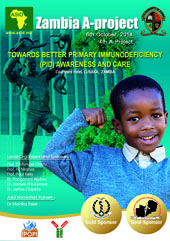Jeddane L. Ailal F.
Clinical Immunology Unit, Pediatric Infectious Department. A. Harouchi Children Hospital, Ibn Rochd Hospital. King Hassan II University. Casablanca, Morocco.
Signal Transducers and Activators of Transcription (STATs) is a superfamily of proteins that play essential roles in development, proliferation and immune defense. The first one to be described in 1989, STAT1, is a key transcription factor mediating interferon (IFN)-α/β signaling [1]. STAT1 is also involved in IFN-γ and other cytokines signaling pathway [1]. Mutations in this gene result in four different clinical phenotypes: complete or partial AR deficiencies leads to susceptibility to intramacrophagic bacterial and viral disease, AD loss-of-function (LOF) deficiency exposes to mycobacterial disease, and AD gain-of-function (GOF) is characterized by candidiasis and auto-immunity [2]. We will see in this mini-review, the epidemiology, the pathogenesis of this deficit and the main clinical manifestations of the four phenotypes.
ST AT1 is activated by tyrosine phosphorylation. Its structure is similar to other STATs, with an N-terminus, a coiled-coil domain (CC), a DNA binding domain (DBD), a Src homology domain (SH2), a tyrosine that is phosphorylated in response to cytokines, and a C-terminus that facilitates transcriptional induction. When IFN binds its cell surface receptor, Janus Kinases (JAKs) associated to the receptor subunits are activated and phosphorylate the receptor on specific residues. Via its SH2 domain, STAT1 is recruited to the proximity of JAKs. Tyrosine phosphorylation of STAT1 by JAKs promotes its ability to bind DNA targets. Indeed, phosphorylated STAT1 can form homodimers, heterodimers or mutlimers, which are translocated to the nucleus, where they bind to conserved genetic boxes to activate or modulate specific gene targets [1]. Accumulation of STAT1 in nucleus was observed within minutes following IFN-γ addition [1]. STAT1 is then dephosphorylated in the nucleus and exported back to the cytoplasm, within hours following IFN activation (Figure 1).
![Figure 1. Signalling pathway and re-cycling of STAT1 after IFN stimulation [from Boisson-Dupuis et al., 2012]](/images/stories/minireview/stat1_fig1fr2.jpg)
STAT1 knockout mice were generated in 1996, showing low expression of CD4+ CD25+ T regulatory cells, poor response to IFN- α/β and IFN- γ, and thus high susceptibility to most viruses and intracellular bacteria and some parasites. However, inborn errors of human STAT1 have only been described since 2001. The first STAT1 defect to be described in Human was autosomal dominant (AD) loss-of-function (LOF) STAT1 deficiency, described in patients showing Mendelian Susceptibility to Mycobacterial Diseases [2]. Unlike STAT1 KO mice, these patients are only susceptible to a restricted spectrum of infections, as only the response to IFN-γ and IL-27 is impaired. Eighteen patients have been reported since 2001, whom 2 from Morocco (unpublished data). All dominant-negative mutations were missense, affecting DBD, SH2 or even the Tyrosine 701 itself, however they showed incomplete penetrance as genetically affected relatives of index cases have remained clinically healthy [2]. Compared to other genetic defects in MSMD, AD LOF STAT1 deficient patients didn’t present susceptibility to Salmonella, nor infection by M. tuberculosis [3]. However, similarly to partial IFN-γR1 deficiency, some patients presented multifocal osteomyelitis [3].
Complete autosomal recessive (AR) STAT1 deficiency is characterized by a broad susceptibility to intracellular bacteria (mainly mycobacteria) and viral (typically herpes virus) diseases. Six patients have been described since 2003 [2]. The known patients carried biallelic LOF alleles, leading to complete absence of the wild-type protein and were unresponsive to IFN-α, IFN-γ and IL-27 [2]. This complete deficiency showed to be lethal, and 4 of the 6 patients died early in absence of a hematopoietic stem cell transplantation (HSCT) and another in the course of HSCT. The last patient was still alive one year after HSCT [2].
In contrast to complete AR deficiency, partial AR STAT1 deficiency is due to hypomorphic mutations and is not lethal. Five patients from 3 kindred have been reported since 2009 [2]. They carry biallelic missense mutations, leading to reduced STAT1 production (10-25% of normal amount). Three of the 4 mutations described were splice mutations, accounting for partial nature of the defect [2]. Patients presented milder intramacrophagic bacterial (Salmonella, M. Avium, BCG) and viral (typically herpes viruses) diseases. However, these diseases were manageable on antibacterial or antiviral drugs. One patient died at 3 years of age, following disseminated mycobacterial disease. The other patients are doing well and are now in their teens [2].
The last inborn error of human STAT1 to be described is also the more common. Since 2011, 114 patients have been reported to date, whom 4 from Morocco (unpublished data), with an AD gain-of-function (GOF) disorder [2, 4-6]. Patients are characterized by chronic mucocutaneous candidiasis (CMC) and autoimmunity [2]. These patients carry missense mutations affecting the CCD or DBD of STAT1, leading to a gain-of-phosphorylation (response to cytokines 2 to 3 times stronger) generally associated by impairment of nuclear dephosphorylation [2]. Autoimmunity have been explained by enhancement of the IFN-α/β cellular response, and CMC by a profound defect of IL-17- producing T cells, due either to excessive response to IL-17 T cell inhibitors, either to diversion from the STAT3 pathway. Clinical penetrance appears to be complete [2]. AD GOF STAT1 mutations have also been described in APECED patients, as well as in IPEX-like patients [5].

In conclusion, STAT1 mutations lead to various clinical phenotypes and should be considered in front of any susceptibility to mycobacterial infections, associated or not to severe viral infections, as well as in front of chronic mucocutaneous candidiasis with autoimmunity.
References
- Reich NC. STATs get their move on. JAK-STAT 2013; 2(4):e27080.
- Boisson-Dupuis S, Kong XF, Okada S, Cypowij S, Puel A, Abel L, Casanova JL. Inborn errors of human STAT1: allelic heterogeneity governs the diversity of immunological and infectious phenotypes. Curr Opin Immunol.2012; 24(4):364-378.
- Hirata O, Okada S, Tsumura M, Kagawa R, Miki M, Kawaguchi H, et al. Heterozygosity for the Y701C STAT1 mutation in a multiplex kindred with multifocal osteomyelitis. Haematologica. 2013;98(10):1641-9.
- Soltész B, Tóth B, Shabashova N, Bondarenko A, Okada S, Cypowyj S, et al. New and recurrent gain-of-function STAT1 mutations in patients with chronic mucocutaneous candidiasis from Eastern and Central Europe. J Med Genet. 2013;50(9):567-78.



























